It would be unfair to judge Marco Rose’s RB Leipzig solely based on some past defeats.
As the team’s new German manager, he took over in September after Domenico Tedesco‘s firing.
Currently, they sit in fifth place in the Bundesliga, trailing Freiburg by just two points, and have a shot at reaching the UEFA Champions League next season.
Despite suffering a crushing 7-0 loss to Manchester City in the UEFA Champions League, RB Leipzig bounced back with a strong victory, only to suffer another loss to Xabi Alonso’s shining Bayer Leverkusen in their latest match.
In this scout report, we will conduct a tactical analysis to determine whether Marco Rose’s tactics and style of coaching align with Red Bull’s corporate football philosophy.
But first, let’s discuss what this philosophy entails briefly.
Redbull philosophy short clarification
Red Bull, the owner of several football clubs worldwide, including RB Leipzig in Germany, Red Bull Salzburg in Austria, Red Bull Bragantino in Brazil, and New York Red Bulls in the United States, follows a unique football philosophy.
The company emphasises the development of young talents and play a proactive, high-pressing, counter-pressing style of football with direct, vertical, and quick attacking play to score goals as quickly as possible.
It made them one of the groups that have a clear identity in the world of football.
Red Bull also employ data and analytics to make informed decisions and they have developed their own data analysis tools to assist coaches and analysts in assessing player performance and making strategic decisions.
In addition, Red Bull supports academic initiatives aimed at identifying and nurturing young players suitable for its clubs, such as Haaland, Werner and others.
To maintain consistency with its philosophy, Red Bull selects coaches who share its approach.
Ralf Rangnick, Max Eberl and Julian Nagelsmann are prime examples of directors and coaches who fit this style perfectly.
Marco Rose was already familiar with Red Bull’s football philosophy before he joined RB Leipzig.
He spent two years as the coach of the first team in Red Bull Salzburg and six years in total with the club which helped him develop a deep understanding of the company’s footballing style.
As a result, it was easy for Rose to delegate and continue implementing the same ideas in RB Leipzig after a disappointing period with Tedesco.
Proactive vertical play
Since Marco Rose took over at RB Leipzig, he has implemented various formations, such as 4-2-3-1, 4-4-2, and 3-4-3 to diversify the team’s playing style.
Regardless of the formation used, Rose places great emphasis on the double pivot during the build-up.
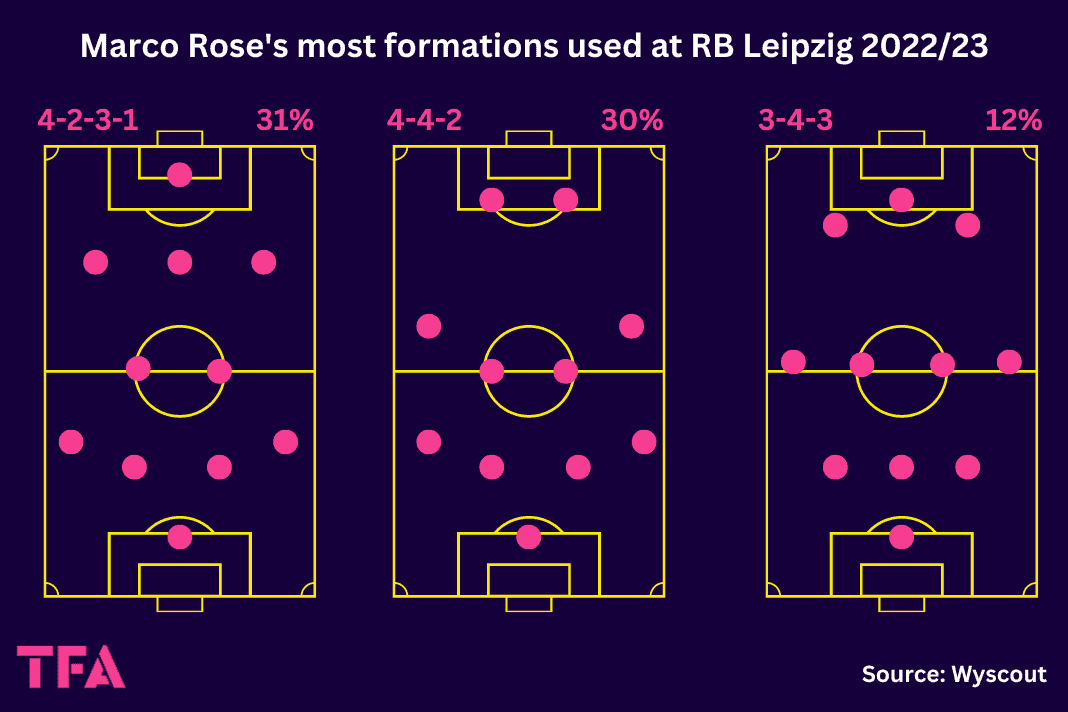
When building up play from deep zones, Leipzig typically uses a 4-2 base.
They employ a lot of direct play forward and combinations, creating space and exploiting it dynamically on the sides.
Players in the last line are prepared to exploit spaces behind the opposition’s backline through direct, deep runs to arrive at the goal as quickly as possible.
In general, RB Leipzig relies heavily on their fullbacks in the first phase of the build-up.
For example, when facing narrow high-pressing opponents like Wolfsburg in the below image.
The ball holder, centre-back Joško Gvardiol, plays to David Raum who will be pressed immediately, but in a usual pattern, one of the pivots, Schlager, drifts and takes advantage of the space there to receive, while the opposing fullback is pinned higher wide by the winger.


From that point, Leipzig depend on the vertical axis more and more, as the vertical passing allows for instant ball progression past one or sometimes two lines of opposition pressure.
Whilst this approach, vertical progress, usually may be used to create third-man runs and speed combination play, it also has different techniques such as passing speed, time and the destination, and the support in front and behind that the targeted player has.
For instance, a vertical pass to a less mobile player like André Silva will be completely different than playing it to Forsberg as Silva is not comfortable receiving the ball with his back to goal and changing direction in one fluid movement so he would lay it off.
Therefore, there must be support in front.
On the other hand, here below, Forsberg receives the slower pass that gives him time to turn.
Meanwhile, Timo Werner and Silva are in 1v1 situations, gaining dynamic superiority in a large space.


Marco Rose usually constructs his team statically in a predetermined shape during the build-up phase to execute the previously mentioned ideas.
Here against Bayern Munich, RB Leipzig focused on progress through the right side, while the opposite winger, Werner, positioned himself in the half-space, ready for a potential deep run.
Konrad Laimer drifts and receives as the third man from the right back.

Indeed, it was a smart example of how a predetermined shape in the build-up can lead to both static freeing of space and dynamic utilisation.
In the 1-1 draw against Manchester City, Pep Guardiola’s team implemented their trending 4-2-4 high-pressing scheme which involved passive pressure from the front two and active pressing from the wingers who stepped up diagonally to press the centre-backs and block the lanes to the fullbacks.
This blocked RB Leipzig’s fullbacks for easy, direct access, prompting Marco Rose’s team to seek vertical play through the dropping winger Szoboslai.
He laid off the ball to the right-back Kolestermann (the third man), who had ample time and space to progress.

Szoboslai’s dropping movement had provoked Ake to follow him, which opened up space in Manchester City’s backline.
Then, Forsberg moved widely behind Ake, generating a central space that could be potentially exploited by Laimer and Werner with their vertical or diagonal runs.

This season in the Bundesliga, RB Leipzig have attempted the second-highest number of live-ball passes behind Bayern Munich, according to FBref.
They have attempted 15,670 live-ball passes compared to Bayern’s 18,045.
However, they lead the league in completed throw passes, which are passes sent between back defenders into open space.
They have completed 78 throw passes, while Bayern are in second place with 68.

In the progression and final-third phases, RB Leipzig’s wing-backs or fullbacks, based on the formation, play a crucial role in stretching the opposition’s defensive lines which open spaces to exploit.
In the graphic below, for example, Lukas Klostermann executes a 1-2 combination with André Silva, who drops deep to receive the ball.
Meanwhile, Amadou Haidara makes a forward, diagonal run to occupy the space created by Silva’s movement, positioning himself as a third man.
This kind of fluid and dynamic play is typical of RB Leipzig’s attacking style, and it often catches their opponents off-guard.

In the DFB-Pokal game against Borussia Dortmund, Marco Rose deployed a 3-4-3 formation.
In the following play, Henrichs maintained width and received a pass from the centre-back Simakan.
Meanwhile, Szoboslai and Werner pinned Dortmund’s two centre-backs, creating a gap between them.
This space was exploited by Laimer, who made a deep run and was in a promising position to score, but unfortunately missed the chance.

RB Leipzig’s ability to exploit spaces behind the opposition’s backline was demonstrated in Timo Werner’s goal against Augsburg.
Kampl played a long ball in behind, and Werner, who had started a diagonal deep run earlier, received it and scored with a brilliant shot.


In a Bundesliga match against the league leaders, RB Leipzig faced a 5-4-1 low block with Brandt dropping into the backline.
With tight gaps, David Raum made a diagonal, deep run to receive a long ball from Schlager.
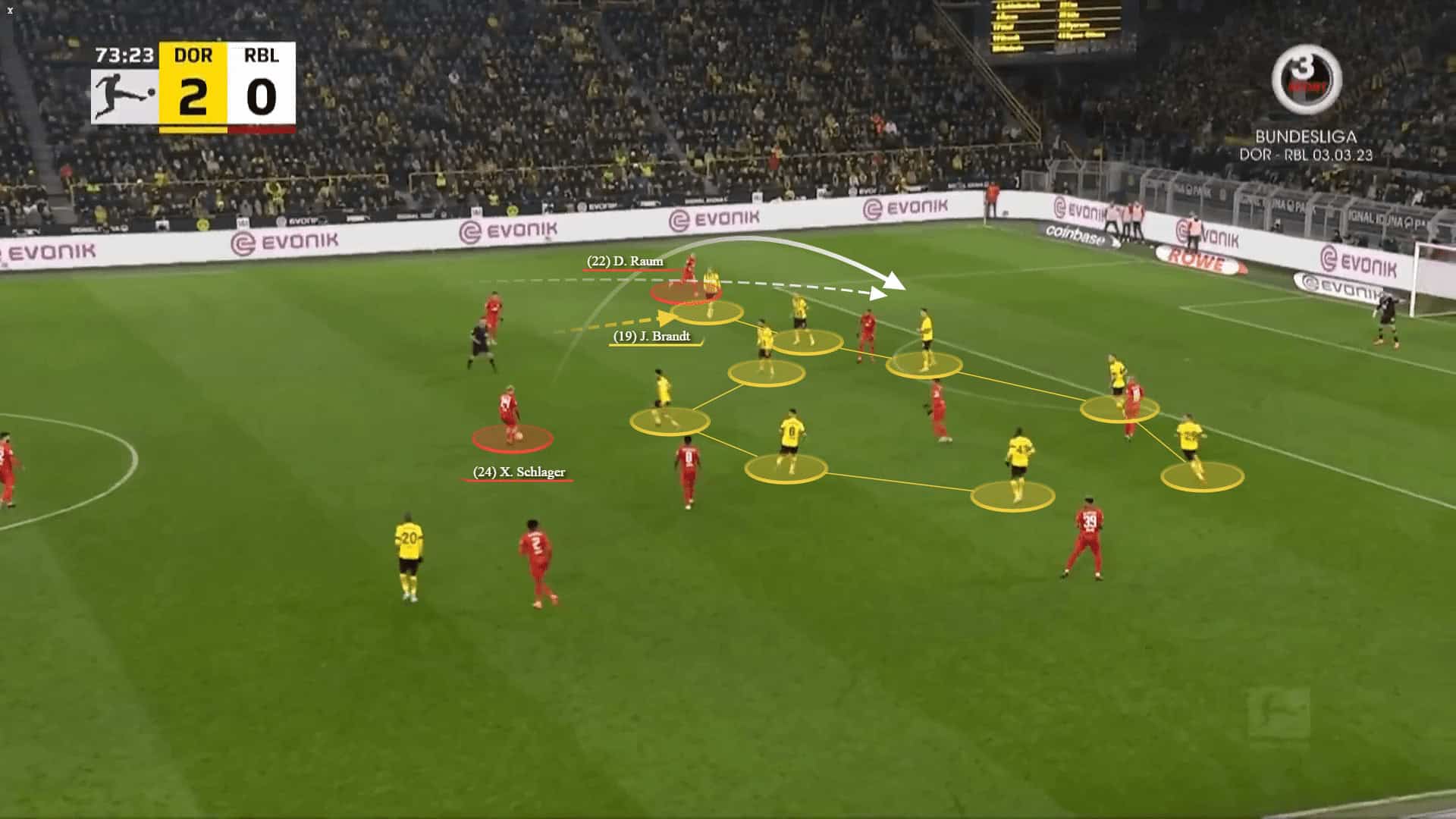
The left-back hit a driven cross with power and speed towards Forsberg who scored the opening goal.
It is worth noting that RB Leipzig often prefer cut-back, driven and low crosses rather than traditional high crosses into the box.
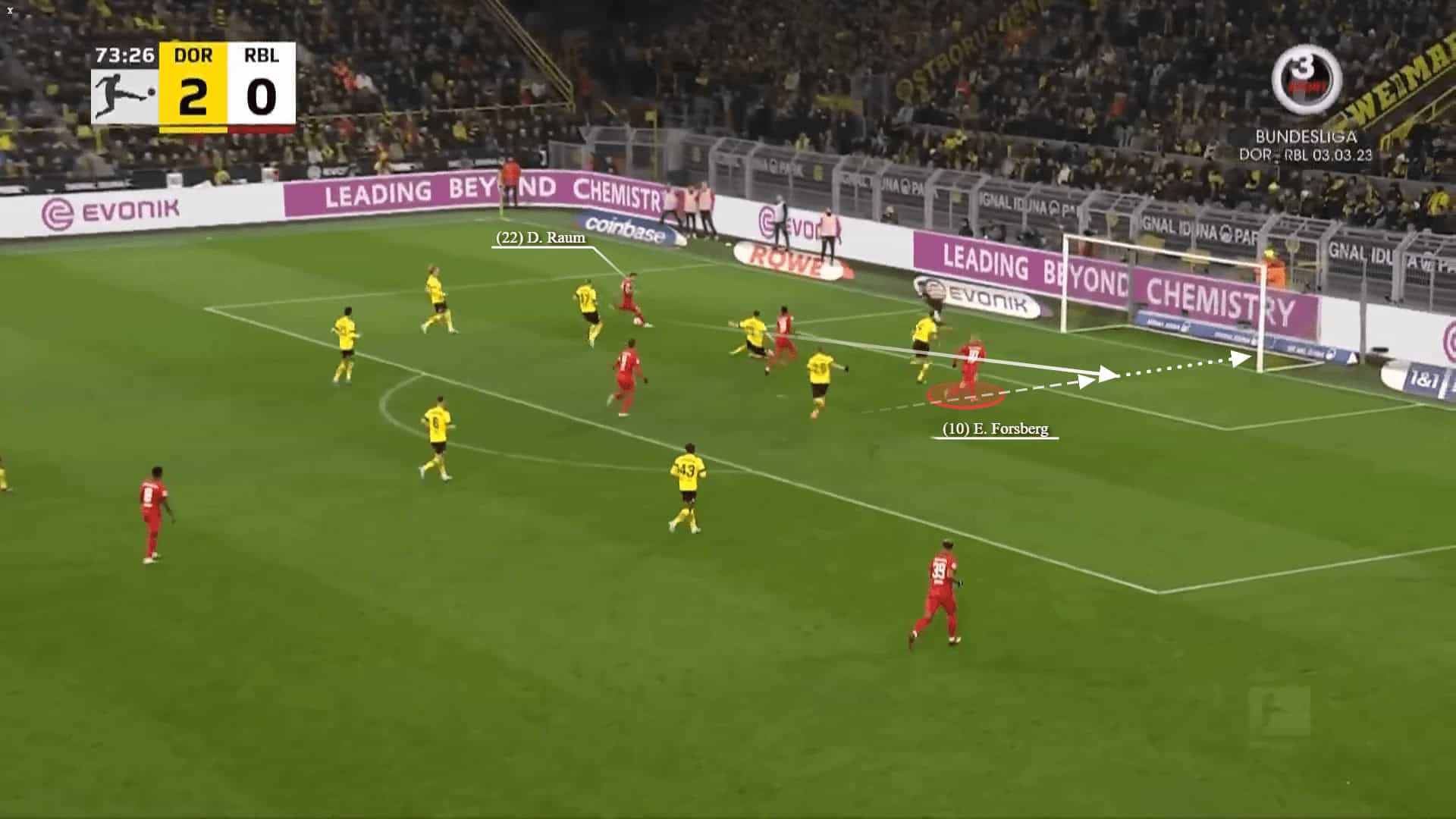
Here below is Timo Werner’s progressive run graphic for this season which illustrates the diagonal movements he makes.
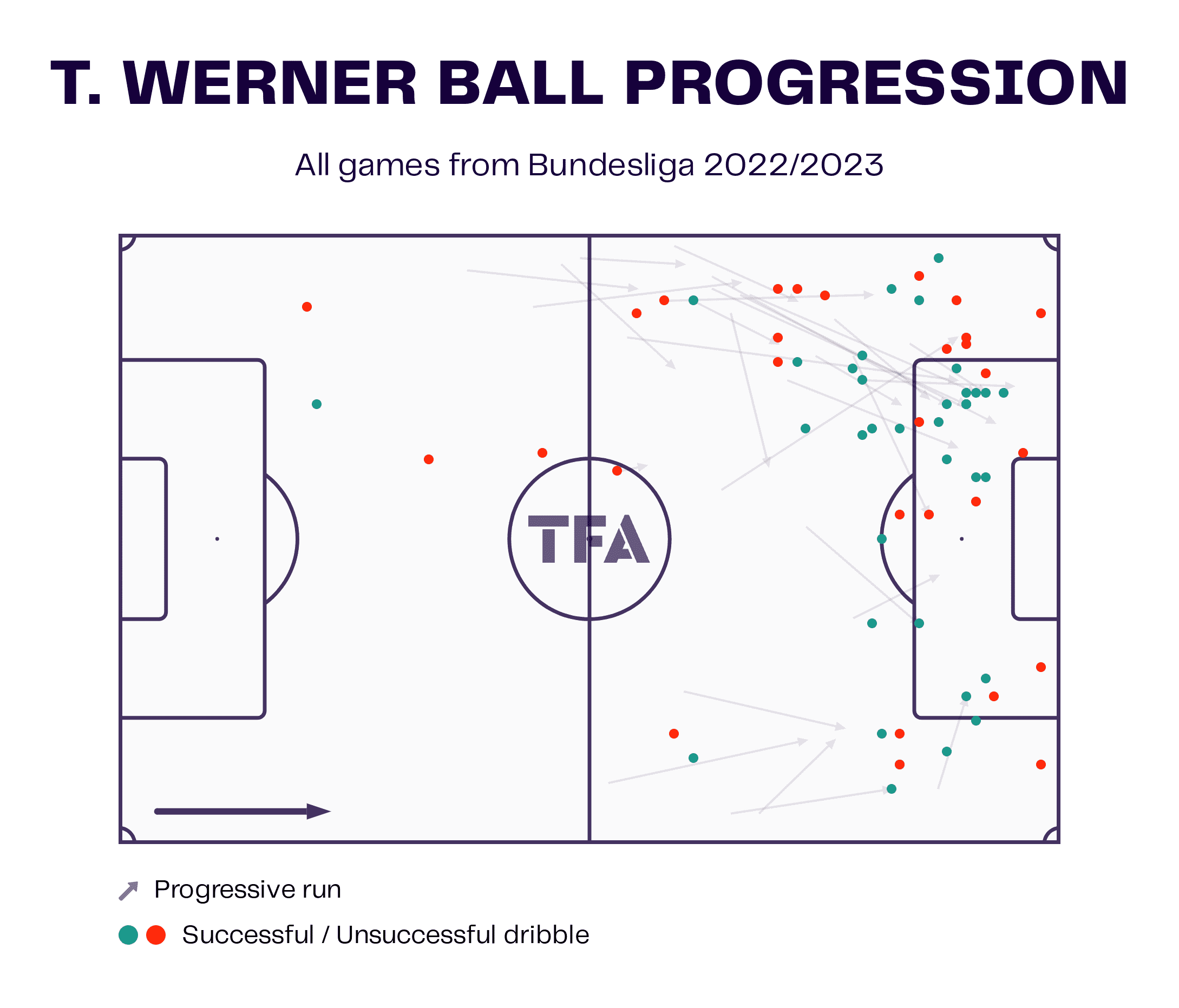
High-intensity pressing
RB Leipzig’s approach out of possession is noteworthy as they employ different high-pressing schemes (hybrid or positional) to regain possession quickly.
The team maintains various schemes with the main reference point being the ball, pressing with intensity to win it back as early as possible.
In the example below, they effectively blocked the depth and directed the play sideways, using the sideline to trap and regain possession.


The comparison between RB Leipzig and Bayern Munich in terms of high regains, dangerous recoveries and counter-pressing recoveries is still relevant.
It shows that, while Bayern Munich have a slightly higher number of high regains, RB Leipzig are not far behind and are still able to make a significant number of dangerous recoveries and counter-pressing recoveries.
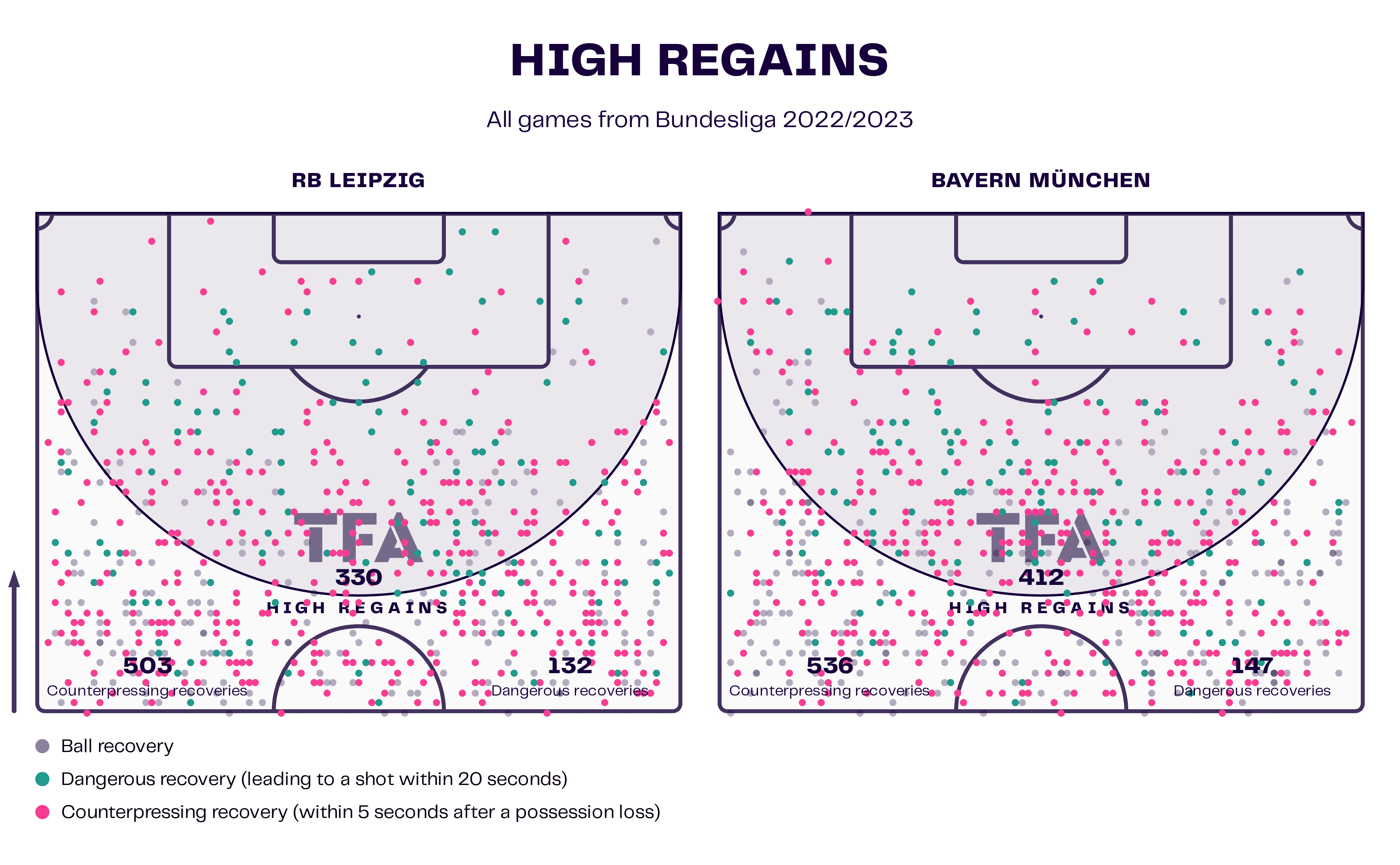
Playing with a high press often involves the risk of maintaining a high defensive line and RB Leipzig tend to have a higher one on the pitch than the Bundesliga champions Bayern, as illustrated in the graphic below.
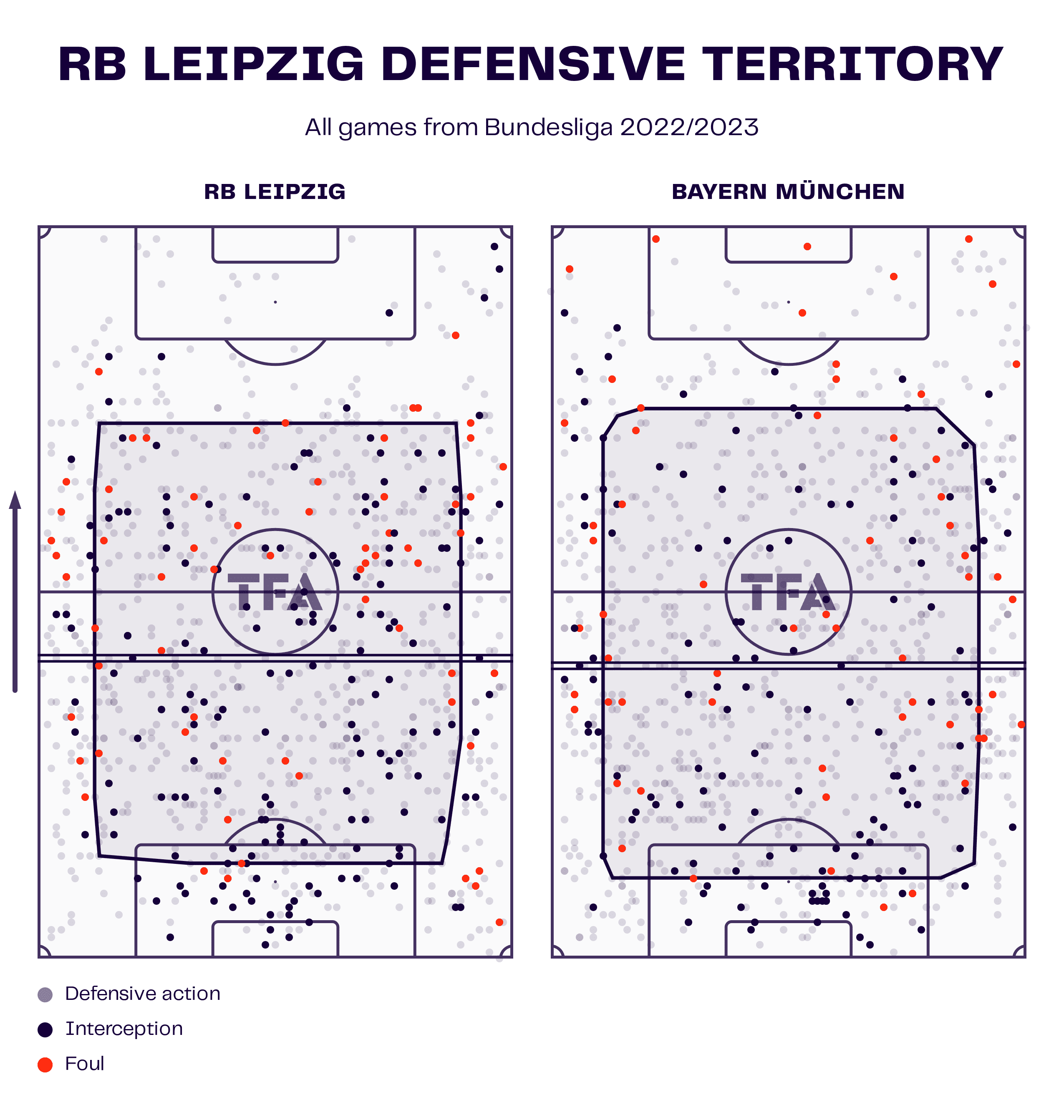
To maintain a high defensive line, it is crucial to have players on the last line like Joško Gvardiol who provides support and cover to the whole of the defensive line with his pace.
In the below graphic, we can see the Croatian’s defensive territory versus two of the best centre-backs in the Bundesliga, Dayot Upamecano and Nico Schlotterbeck.


Joško Gvardiol has drawn interest from several top clubs due to his abilities as a modern, left-footed centre-back both in and out of possession.
His pace, defensive skills, composure on the ball, and tactical awareness make him a well-rounded player capable of adapting to different game situations.
It is no surprise that his talent has caught the attention of several big clubs who are interested in securing his services.

Accordingly, they are keen on pressing the opponents high.
They have some conceptions when making traps or initiating the press even from lower positions as they wait for specific triggers (square or back pass) to force the play into a specific direction to start the press again.
Here below, they stayed in a 4-2-3-1 mid-block, maintaining compactness, that forced the play to the side and then they initiated the press while overloading the ball-near area with a 5v3 numerical advantage.
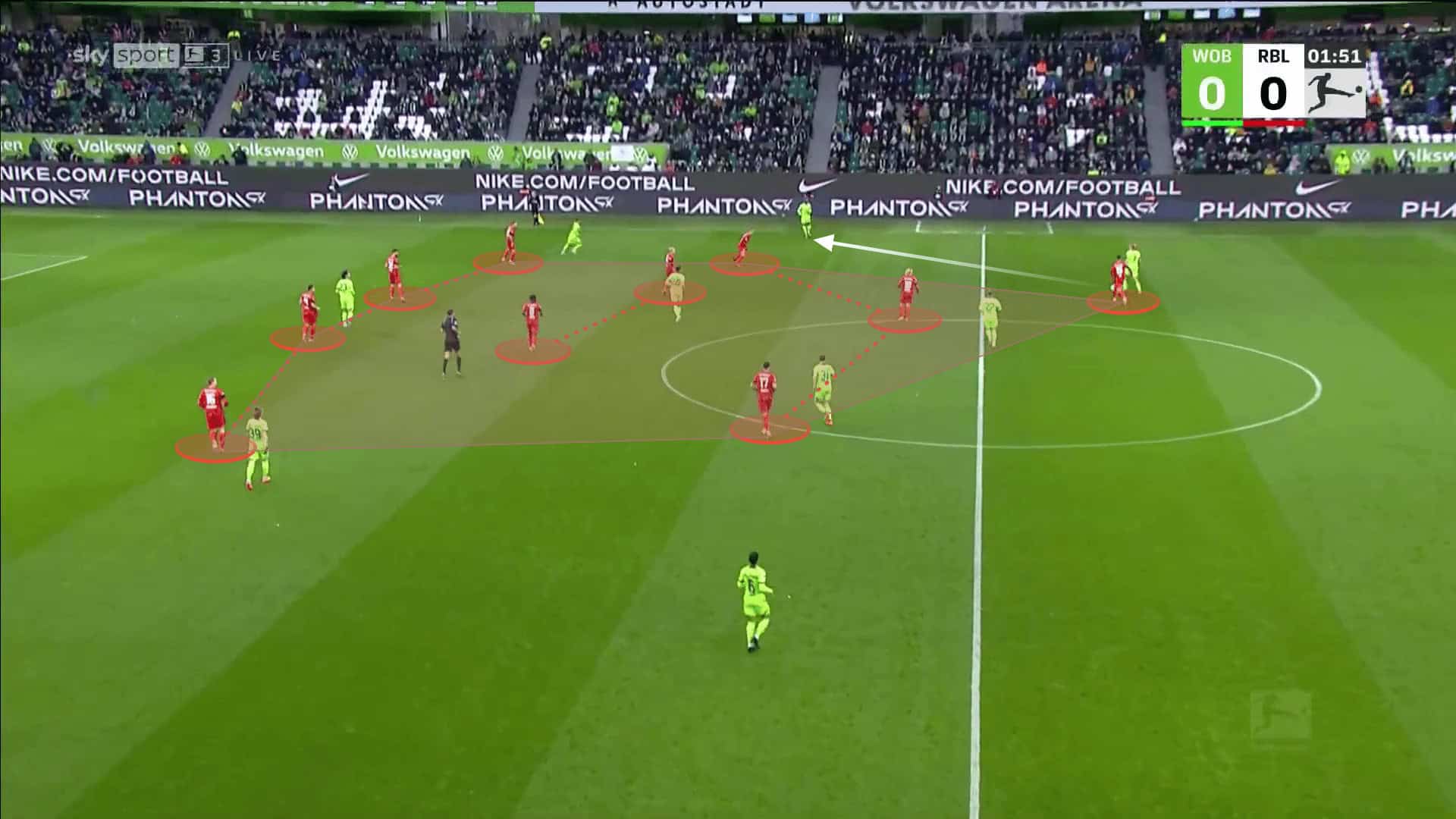

Once the ball has been forced backwards (pressing trigger), RB Leipzig players move forward immediately to initiate the press with intensity and speed.
Once Wolfsburg’s left centre-back receives the ball, the starter (white circle) initiates the press, creating the trigger, and attacks the ball carrier with intensity, giving him less time to make a proper decision.
It is important when directing the play in a specific direction to screen and block the others.
At the same time, the pressing second wave should be predicted by the players (yellow and red dots) in the new possible direction of the ball, predicting the play and increasing the intensity and jumping there to press the possible second pass.

Meanwhile, the cover player compresses the area around the ball to create a numerical advantage and increase their chances to regain possession.


Conclusion
This has been a tactical analysis of RB Leipzig’s playing style under Marco Rose who became their manager on September 8, 2022, and how he has continued Red Bull’s football philosophy which emphasises developing young talents and playing a proactive, high-pressing style of football with direct, vertical, and quick attacking play.
Is it possible to see them next year in the UEFA Champions League?





Comments